Check mail in Exchange 2007 (Part 2)
In part one of this article we looked at the default configuration of message tracking within Exchange 2007 and how to change those settings using PowerShell cmdlets. You can remember those major changes in Exchange 2007 mail checking on their Exchange 2003 replica :
- Message checking is enabled by default.
- Recording is also enabled by default
- The default records are retained for 30 days.
There are really many changes but we don't go into the first part. In this second part, we will look at the contents of the log file then how to find them in practice.
What is a record?
You can see Figure 1 below, the log directory is shown with two log files contained within it. A familiar message tracking log directory is shown when I use the cmlet in part one of the article to change the log path to D: Tracking Logs. The first thing you should notice is the file names. They are set in the following formats:
MSGTRKyyyymmdd-n.log
MSGTRKMyyyymmdd-n.log
This format gives us the following information:
- MSGTRK is located at the top of the log files in Hub Transport or Edge Transport server.
- MSGTRKM is located at the beginning of the log files in the Mailbox server.
- yyyy is a number that represents the number of years of the file created.
- nm is its number of months.
- dd is the number of days
- n is the increment count in units of days.
You can see in Figure 1, where they have log files that start with both MSGTRK and MSGTRKM on the same server. Therefore, you can reduce both the Hub Transport and Mailbox server configured on this single server. The first log file created is named MSGTRK20061217-1.log. When the file is the largest, 10MB is the default value, the next record will be named MSGTRK20061217-2.log.
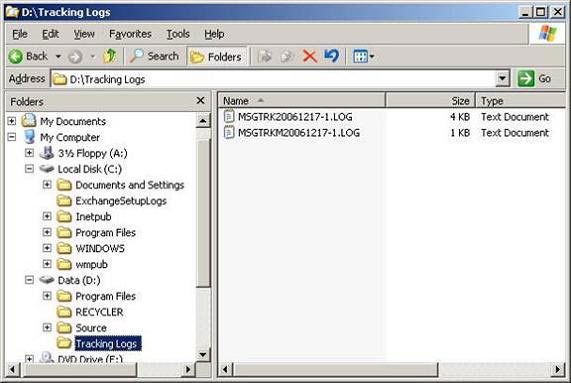
Figure 1 : Log file name
Figure 2 shows the contents of a sample message tracking log file taken from a Hub Transport server. The first thing to note here is that the data is in CSV format (Comma Separated Value: comma separated values). Figure 3 is a comparison of this problem with the sample record of Exchange 2003.
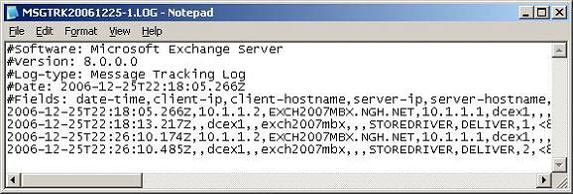
Figure 2 : Content of the message tracking log file of Exchange 2007.
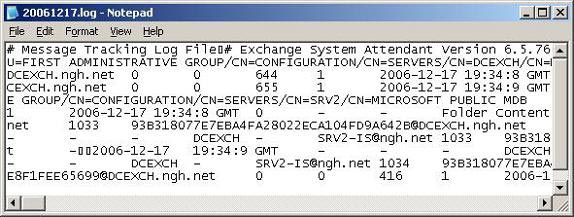
Figure 3 : Content of the message tracking log file of Exchange 2003.
From Figure 2 you will see that, the first few lines of the log file contain the file system information. It includes the following order heahder: #Software, #Version, # Log-Type, #Date, #Fields (# software, # versions, # types, # days, # fields). Explain these headers as follows:
- #Software . This is the name of the application that created the log file, in which case they are set to the value of Microsoft Exchange Server.
- #Version . This is the version number of the application that created the log file. In my test with a trial version of Exchange 2007 RTM, this value was set to 8.0.0.0. This issue is also a case of Exchange 2007 Beta 2.
- # Log-Type . This is the type of log file created by the application, in which case it is set up on the Message Tracking Log
- #Date . This is the date and time that the log file was created and expressed in the format yyyy-mm-ddThh: mm: ss.fffZ . You can almost guess that yyyy is the year, mysql-z is the month and the right, hh for the hour and mysql-zrm seconds and minutes.
- #Fields . This is a field list of comma-delimited lists, the name of the field is date-time, client-ip, client-hostname, server-ip, server-hostname, source-context, connector-id, source, event-id, internal-message-id, message-id, recipient-address, recipient-status, total-bytes, recipient-count, related-recipient-address, reference, message-subject, sender-address, return-path, message-info.
We won't go into too much detail for the fields inside the article that have a description with help files. To be honestly friendly, with the exception of a few, the great majority must show it more brightly and if you can write and send some messages or reports you can work through each school value to Indicates what is happening.
Search for a record
As you can remember in part one of this article, settings can only be configured using the Exchange Management Shell (EMS); No method can be configured through the Exchange Management Console (EMC). If you prefer to use graphical tools when administering Exchange, you can use the Message Tracking tool to check messages to find the contents of the log files. Obviously you can use EMS but you should be aware that there are some differences between them. We will introduce both of these methods here and show the differences between them.
First, look at using the Message Tracking tool to find log files. There are many reasons why we introduced you to this tool first and that is simply because the corresponding cmdlet that you ran will be displayed inside this tool, which makes it easy for you to use it. Use EMS later. Here's how to run the Message Tracking tool.
1, Run the Exchange Management Console.
2, In the window on the left, select Toolbox .
3, In the middle of the results section, select Message Tracking from Mail in the tools area.
4, Now you can select the Open tool option on the right or you can right-click Message Tracking in the results section and select the Open tool from the menu. This way if you do not see the Action Pane, it may be due to the current hidden view via the View menu option inside the EMC attached software module. Click View , then Customize . and in the Customize View window you have to make sure that the Action option is selected.
5, A new window will open showing you Microsoft Exchange Troubleshooting Assistant. If this is the first time you have chosen this option, you can skip a few screens to choose to upgrade. Finally you should stop at the screen as shown in Figure 4 below.
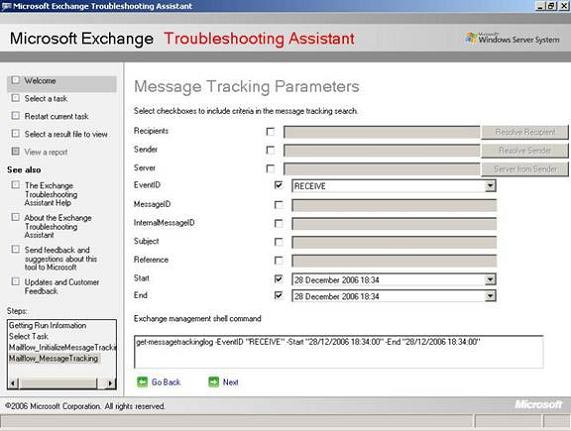
Figure 4 : Notification test tool
Here you can fill in relevant search filters such as senders, recipients, mailing topics . There are some sections here that you should pay attention to:
- At the bottom of the screen, the Exchange management command area shows the corresponding cmdlet that you can perform the same search through EMS.
- Note Figure 2 about the date and time of saving test records in Coordinated Universal Time (UTC) format when the search shown in Figure 4 uses local time and date formats. The mail checker tool will perform the conversion process for you.
- The EvenID search field has many different options such as RECEIVE , used to find messages received by the relevant server, or DELIVER , which is used to search for messages distributed to each mailbox.
For example, to perform a simple search for messages with the word 'hello' within the subject line, you must perform at least two tasks in Figure 4. You first need to click on the Subject check box and supply the keyword 'hello' to the next field next to it. Next, you need to make sure that the end date must be after the start date. By default these days are the same and cannot change the final day results while performing a search. In some cases, if you have separate Mailbox and Hub Transport servers and are performing a search from the Mailbox server, you will need to change the EventID to the SUBMIT option, when Mailbox servers only have SUBMIT events. . These problems are also used to check when Mailbox servers submit messages to the Hub Transport server. You will no doubt call from your Exchange 2007 reading about whether all mail goes through Hub Transport servers.
Given that you have entered valid details and clicked on the Next button, you will see a screen similar to the one shown in Figure 5 below.
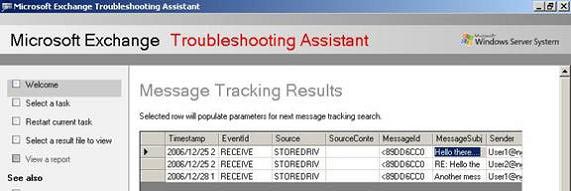
Figure 5 : Results through the mail test tool.
Note that the text that says the selected row will populate the parameters for the next message check. This shows that whatever is selected as the message subject line in Figure 5 will be used as the basis of the next search when you click the Next button at the bottom of the screen.
A notable extension here with checking mail depends on the Microsoft Exchange Transport Log Search service . You may have seen on Exchange 2007 a large number of Exchange-related services within the Services applet. Finding test logs requires running Microsoft Exchange Transport Log Search service. If the service is not running, you will only see the error message shown in Figure 6. Note that if you disable this service for any reason, the ability to search the log files will be affected. ; There are no Exchange functions affected.
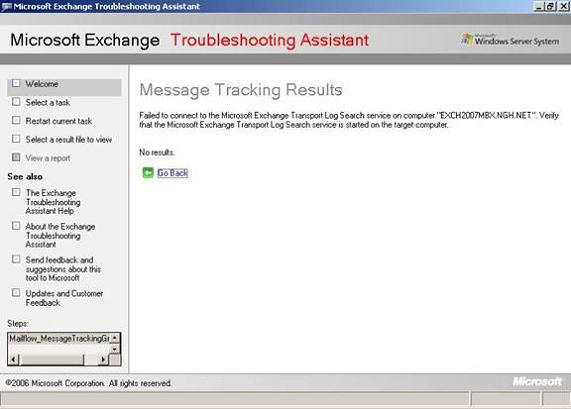
Figure 6 : Error checking mail
Now let's look at using EMS to search log files. This function focuses around using the Get-MessageTrackingLog cmdlet. You can use this cmdlet without any options, which will result in 1000 items of items being displayed. therefore, many parameters are added to the cmdlet to enrich our search. You can limit the number of inputs returned by using the ResultSize result size parameter. To repeat our previous search, we can simply paste into the cmdlet, so the Message Tracking tool will show us. This is shown below:
Get-MessageTrackingLog –EventID 'RECEIVE' –MessageSubject 'hello' –Start '01/12/2006 00:00:00' –End 'December 28, 2006 18:50:00'
Note that in our example, the start and end dates are displayed in UK format.
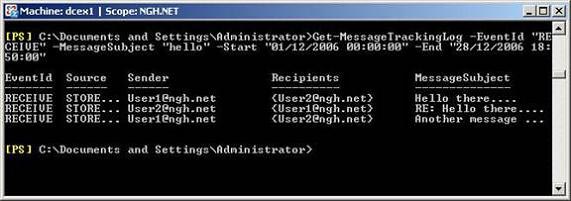
Figure 7 : Mailing test results via EMS
You will see in Figure 7 that the 5 default fields shown are EventId, Source, Sender, Recipients and MessageSubject. If you use the format list or fl formatting cmdlet, you can get more information. For example, Figure 8 shows you the details of the first search result listed in Figure 7. Obviously, you also have the option to resend the cmdlet results to the text file by appending data. Data like > 'C: results.txt' at the end of each cmdlet.
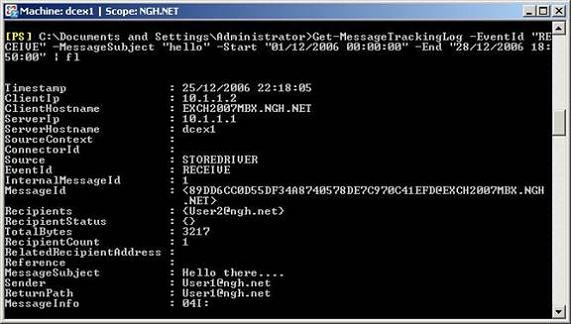
Figure 8 : Mail test results using the EMS format list
Logical reasoning finds that this gives you the most sense of using the Message Tracking tool first and seeing what the corresponding cmdlet is. When you are comfortable with the relevant cmdlet, you can choose to use EMS only. However, this choice is yours.
To complete the process of considering using EMS to find log files, you should not forget that if the Microsoft Exchange Transport Log Search service is not running, an error will be encountered in the same way as you. implemented within the Message Tracking tool. In the case of EMS, you will see the error shown in Figure 9.

Figure 9 : Error finding Message Tracking (EMS)
Difference
Is there any difference between using the Message Tracking tool and EMS? Yes, yes, you will first see as in Figure 4, the Message Tracking tool provides the server field as a search filter. If you use the server parameter inside EMS, it is actually used to name the server that the message tracking log files you expect to find.
Alternatively, EMS has a Reference search filter (Reference) not contained within the Message Tracking tool. This search filter is linked to the reference field within the actual record, which includes information such as the DSN (Delivery Status Notification) ID messages.
summary
Through the two parts of the article, we gave you a useful working knowledge on how to check messages that are configured by default, how to change the configuration and how to perform searches. basic knowledge. Of course, finding logs for information will be different for each reader, so we recommend that you use some Message Tracking tools and command line interfaces.
You should read it
- Transfer mailboxes in Exchange 2007 through the Exchange Management Console
- Forward from Exchange 2000/2003 to Exchange Server 2007 (part 2)
- Share Hosting with Exchange 2007 (Part 1)
- Create a custom management interface for Exchange 2007
- Backup for Exchange Server with DPM 2007 (Part 1)
- Backup for Exchange Server with DPM 2007 - Part 3: Backup process
- Manage Exchange Server 2007 using Windows XP workstation
- Manage the Exchange Server 2007 log files - Part 3
May be interested
- Check Exchange 2007 with System Center Operations Manager 2007 - Part 3
 in this section we will introduce the detailed configuration of the exchange 2007 admin package for system center operations manager (opsmgr) 2007.
in this section we will introduce the detailed configuration of the exchange 2007 admin package for system center operations manager (opsmgr) 2007. - Prepare Active Directory for Exchange 2007 (Part 2)
 in part one, we went over the first four steps to take to prepare the active directory schema to receive exchange 2007.
in part one, we went over the first four steps to take to prepare the active directory schema to receive exchange 2007. - Enterprise e-mail management with Exchange Server 2010
 exchange server is a server software developed by microsoft that specializes in e-mail solutions and information exchange within businesses.
exchange server is a server software developed by microsoft that specializes in e-mail solutions and information exchange within businesses. - Access Exchange 2007 from an Apple Macintosh computer (Part 1)
 this two-part article will examine the different options for exchange access from the apple mac os x computer, specifically including discussions of some experts and researchers in each solution. . from there will p
this two-part article will examine the different options for exchange access from the apple mac os x computer, specifically including discussions of some experts and researchers in each solution. . from there will p - Transfer MDaemon to Exchange 2007/2003 (Part 2)
 in the previous section, we learned how to export and import accounts and passwords from mdaemon to active directory of exchange server systems when needed.
in the previous section, we learned how to export and import accounts and passwords from mdaemon to active directory of exchange server systems when needed. - Prepare Active Directory for Exchange 2007 (Part 1)
 before installing exchange 2007 you need to learn some steps to take to prepare an active directory environment to receive exchange 2007.
before installing exchange 2007 you need to learn some steps to take to prepare an active directory environment to receive exchange 2007. - Managing log files of Exchange Server 2007 - Part 2
 in this article, i will show you some other ways to get log information in exchange server 2007.
in this article, i will show you some other ways to get log information in exchange server 2007. - Transfer MDaemon to Exchange 2007/2003 (P.7)
 in the last part of this series we will perform some administrative tasks that a mdaemon system administrator should know in an exchange server 2007 environment.
in the last part of this series we will perform some administrative tasks that a mdaemon system administrator should know in an exchange server 2007 environment. - Use remote connection analysis tool for Exchange Server - Part 1
 in this article we will introduce you to the exchange server remote connectivity analyzer (exrca) tool so that administrators can validate autodiscover, ....
in this article we will introduce you to the exchange server remote connectivity analyzer (exrca) tool so that administrators can validate autodiscover, .... - Manage the Exchange Server 2007 log files - Part 3
 in this section we will show you how to manage the recording of information on exchange connectors, message tracking, anti-spam agents and message records management features.
in this section we will show you how to manage the recording of information on exchange connectors, message tracking, anti-spam agents and message records management features.










 Works with Recovery Storage Groups
Works with Recovery Storage Groups Secure secure SMTP mail flow between different Exchange Server 2007 organizations
Secure secure SMTP mail flow between different Exchange Server 2007 organizations Debug Mailbox Manager policy application
Debug Mailbox Manager policy application Message queues in Exchange 2007
Message queues in Exchange 2007 Exchange 2007 anti-spam function conversion tool
Exchange 2007 anti-spam function conversion tool Manage Exchange Server 2007 using Windows XP workstation
Manage Exchange Server 2007 using Windows XP workstation